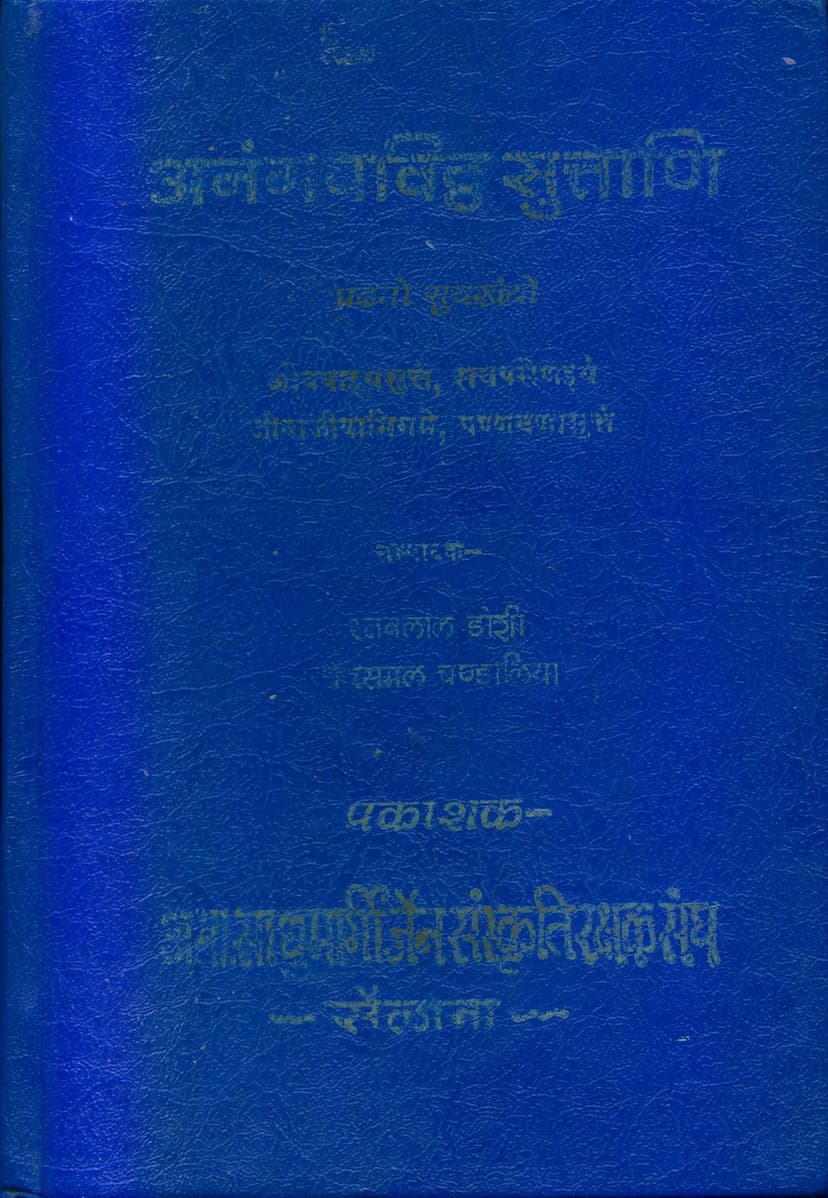Anangpavittha Suttani Padhamo Suyakhandho
Added to library: September 1, 2025

Summary
This Jain text, "Anangpavittha Suttani Padhamo Suyakhandho," compiled by Ratanlal Doshi and Parasmal Chandaliya, published by Akhil Bharatiya Sadhumargi Jain Sanskruti Rakshak Sangh, is the first part of a collection of "Anangpavittha Suttani," which refers to scriptures considered "outside the Angas" (core Jain scriptures). The catalog link provided is jainqq.org/explore/004388/1.
The book is presented as the first installment of a larger project to publish Jain Agamas. The introduction (from page 4 onwards) explains that a previous part, "Angapaviththa Sutani," comprising 11 Anga scriptures, was published in January 1982. This current volume, "Anangpavittha Sutani," aims to publish the remaining scriptures, which are referred to as "Angabahya Shruta" (scriptures outside the Angas). These are categorized into Upanga Sutras, Mula Sutras, and Cheda Sutras.
This specific volume, the first part of "Anangpavittha Sutani," includes the first four of the twelve Upanga Sutras. These are all classified as "Utkalika Sutras" (timeless or always applicable). The text provides a brief synopsis of the content of these four sutras:
-
Ovavaiy Saut: Primarily deals with three subjects:
- Samavasaranadhikara: Detailed description of the Samavasarana (divine assembly) of Lord Mahavir, including the city of Champanagari, the Gunashil Chaitya, the Ashoka tree, King Konika, his devotion, the 12 types of penance, Lord Mahavir's monastic family, and his religious discourse.
- Oupapatikaadhikara: Discussion on Oupapatika prachchha (questions about arising beings), karma bondage, determination of post-death rebirth, and the story of Ambada Parivrajaka.
- Siddhikara: Explanation of Kevali Samudghata (a specific yogic process of enlightened beings), question-answer sessions about liberated souls (Siddhas), and the nature of Siddhas through 22 verses.
-
Rayapasenaiyam: This second Upanga Sutra extensively details the questions posed by Suryabhadra Deva and King Pradesh, and the answers provided by Keshil Shraman.
-
Jeevajivabhigame: This third Upanga Sutra, Jeevajivabhigama, provides a comprehensive exposition of the nature of soul (Jiva) and non-soul (Ajiva), including the description of Vijay Deva. It primarily focuses on the Dhruvadhyai (literally "fixed" or "unchanging" subject) and, in general, discusses all islands and oceans. It contains nine points of understanding.
-
Panna: This fourth Upanga Sutra, known as Prajnapana, contains 36 chapters (pada). Each chapter elaborates on a specific subject. The text mentions that the Agamas (Jain scriptures) describe four types of Anuyoga (commentarial classifications):
- Dravyanuyoga: Describes soul (Jiva), matter (Pudgal), dharma, adharma, akasha (space), kala (time), and other substances.
- Ganitanuyoga: Deals with calculations, including the enumeration of beings in the four modes of existence.
- Charanakarananuyoga: Relates to conduct and practice.
- Dharmakathanuyoga: Involves religious teachings through narratives. The Prajnapana Sutra primarily focuses on Dravyanuyoga, though it also touches upon subjects from Charanakarananuyoga and Ganitanuyoga.
The text also includes editorial notes mentioning the unfortunate passing of Shri Ratanlalji S. Doshi, a significant figure in the publication plan, shortly after the composition of the first eight pages. It expresses gratitude for the guidance received from Shri Jashwantlalbhai Shah and acknowledges the possibility of minor errors due to the author's limitations and the proofreading process, requesting readers to inform them of any inaccuracies for correction in future publications. The editorial also mentions that the second part, containing the remaining Upanga Sutras and Cheda Sutras, has been printed, and the Mula Sutras are in the process of being printed.
A significant portion of the text consists of the actual scripture content, starting with the "Ovavaiy Sutra" in Prakrit (pages 10-26 onwards). This section describes the city of Champanagari, the Punyabhadra Chaitya, the Ashoka tree, King Konika, Queen Dharani, and the arrival and discourse of Lord Mahavir, along with the subsequent interactions and conversions, illustrating Jain philosophical concepts through narrative.
Later pages (from page 8 onwards) delve into details about "Aswadhyay" (non-study) and the circumstances that necessitate avoiding it, listing 34 specific instances related to cosmic phenomena and impurity.
The inclusion of the Prakrit text is extensive, detailing the grandeur of cities, the characteristics of beings, celestial beings, and the teachings of Lord Mahavir, which are central to Jain doctrine. The text covers topics like the nature of souls and non-souls, different categories of beings (Jiva and Ajiva), cosmology, karmic principles, conduct, austerities, and the path to liberation, all presented within the narrative framework of Jain teachings and events.
In essence, this book is a foundational publication for Jain scriptures outside the core Angas, providing access to significant philosophical and narrative texts that are crucial for understanding the broader Jain tradition. It highlights the commitment to preserving and disseminating these ancient teachings.